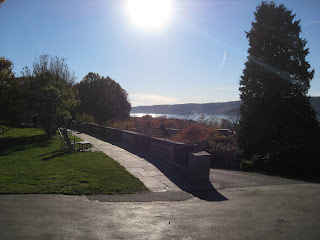A Walking and Hiking Blog. 10,000 steps a day outdoors: walking and hiking our way to stronger bones, better weight control and general good health; Day Hikes,day trips, Manhattan walks, public transportation to trails that peak in and near NYC. Photos, maps and anecdotes.
Tuesday, March 8, 2011
NYC Day Trip to Wave Hill: A Public Garden and Cultural Center, Riverdale, NY
Wave Hill Public Gardens and Cultural Center is a magnificent destination. The views of The Hudson River and The Palisades are only a fraction of the bounty. The 28-acre park offers a gorgeous arboretum, paths of formal, and of "wild" plantings, water lilies and other aquatics, green houses, and historic mansions turned culture center, museum, gift shop and cafe.
It was mid November when we decided to walk our 10,000 steps up in Riverdale.
The ride: from Grand Central Station to Riverdale on Metro North was under 30 minutes.
Wave Hill Gardens, open year round, was a 1-mile walk from the station.
Public Tran: bus and subway directions here
There is a free van that meets every train to transport you to the gardens (5 minute ride), but, of course, walking is the healthier option!
The walk: about 20 minutes, with a hill here and there. Here's Hopstop's street map to follow:
(Detailed walking directions at Hopstop. Use 200 West 254th Street as the starting address and 675 West 252nd Street for the destination at Wave Hill Gardens.)
Drivers: from NYC to 675 West 252nd Street: 12th Avenue north to Henry Hudson Parkway to 252nd Street. Left turn to park. On-site parking for $8. Free off-site parking. Trip takes about 25minutes.
History: Wave Hill was originally developed as a family estate in 1843 by William Lewis Morris. In 1856, it was purchased by publisher William Appleton and used as a summer residence until 1903. During those years, Mark Twain and Theodore Roosevelt were among his tenants. It was then sold to George Perkins, a conservationist. In the 1960s, the Perkins family donated the estate to New York City.
Entrance fees: $8 per adult, 6 for students and seniors, 2 for children.
Closed Mondays except for special holidays.
The website offers vistor's hours,events, tour, van and facility info, printable maps of the gardens and a down-loadable self-guided tree identification walk.
The hot house plants were beauties...
This one seemed equipped with extra terrestial finger tips.
Surprisingly, there was a sign warning viewers that they are watched as they exit, and must not take plants!
So some people try to walk off with these babies?
Back outside, the variety of plants and styles of planting is amazing.
Uh-oh... the bees were busy before the snows of winter. Bullseye: there's one in each!
Labels were welcome for the botanically uninformed, such as we.
What a treat just weeks before winter's start.
The colors and varieties along the winding paths are astounding.
Cotton going to seed?
We didn't see a bee here, so we went in for a close up.
The lilies and other aquatic plants were adjusting to the low light of the season. The pond and arcades can help you review your knowledge of hydophytes, monocots and dicots. Ahem...
This exotic is along the strip leading away from the aquatics.
Back in here is an extensive network of planted paths, all of which are pictured and explained at this excellent link, which includes a live index to all the other planted zones, each viewable in every month of the year!
Back toward the entrance, voila, a papaya tree.
There are many gorgeous long-range views once you return to the open grounds.
Time for the race to see who gets to sit on the mountain chair.
Can you imagine all this as your estate home?
Last, we headed over to the Glyndor building, the gallery of the center.
There were several interesting wall exhibits and this central installation that provoked many guesses.
Just to the far side of the Glyndor building is the picnic area, the only place eating food from home is permitted. The rules are strict here.
Metro North platform, south to Manhattan.
This is truly a garden and park for all seasons. We definitely want to come back at least once a season to witness the changes and learn a little something next time, since we won't be as overwhelmed by the first view of the beauty there.
Let us know if you go!
Subscribe to:
Posts (Atom)























